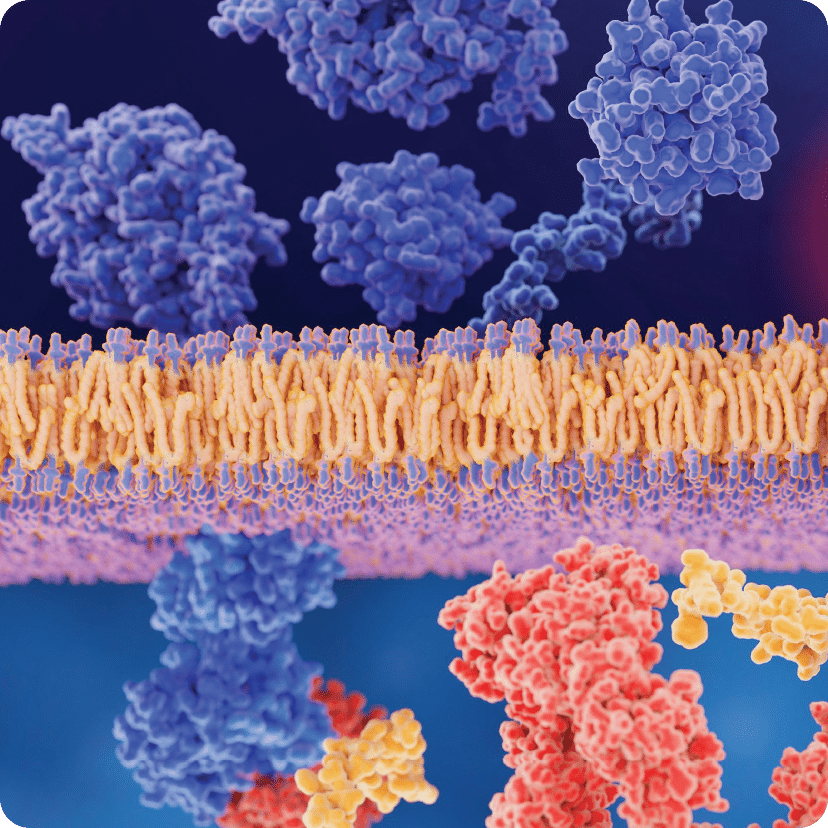Choosing the Right Assay for Your Kinase Drug Discovery
Kinases, the master regulators of cellular signaling pathways, are prime targets for drug discovery. But with so many assays available to measure their activity, how do you choose the right tool for your research? This blog delves into the diverse landscape of kinase assays, empowering you to select the most effective method for investigating your drug targets.
Protein kinases, the prolific signal transmitters of the cellular world, are more than just tiny molecular machines. With around 518 types identified in humans, they form one of the largest and most significant families of proteins, playing crucial roles in regulating cell signalling pathways. This makes them prime targets in the quest for new therapies, especially since their overactivity or malfunction is often at the heart of diseases like cancer, cardiovascular disorders, and inflammatory conditions.
Since the early 2000s, the FDA has given the green light to several kinase inhibitors specifically for cancer treatment, showcasing the critical role of protein kinases in drug development. The focus on these proteins isn’t surprising, given that they represent one of the largest “druggable” gene family within our genome. With about a quarter of all drug discovery research dollars being spent on kinases, the race is on to find small molecules that can effectively target these proteins.

Explore our large portfolio of kinase assays
Leverage our unmatched collection of assays and expert services to accelerate your discoveries
A plethora of assays for measuring kinase activity
The growing interest in kinases has led to the development of numerous assays to assess their activity, each offering distinct advantages and drawbacks. The “paradox of choice” arises as this wealth of options, while advantageous, complicates the decision-making process for researchers attempting to select the singular assay best suited for their kinase exploration. This section aims to distill the essence of these key assays, guiding you through the market of methodologies to measure kinase activity.
1. Radiometric activity assay
Uses radioactive ATP, enabling precise measurement of kinase-driven substrate phosphorylation. It is highly sensitive and versatile, but requires handling radioactive material and specialized waste disposal systems
2. Scintillation Proximity assay (SPA)
Detects phosphorylated substrates via scintillant-coated beads. It’s suitable for high-throughput screening but involves indirect measurement and poses radioactive waste issues.

Table comparing the commercially available kinase assays
3. Mobility shift
Analyzes reactions on a chip or in small plates. It requires precise peptide selection and careful threshold setting for high-throughput screening. Furthermore, it is adept to detect binding but not activity.
4. Ligand binding assay
Measures kinase interaction with ligands, often using immobilized kinases and labeled ligands. It’s sensitive but limited to kinases with known ligands.
5. Enzyme fragment complementation assay
Uses split enzyme fragments that reactivate upon interaction. It’s good for live-cell studies but complex to develop. Moreover, it is are not compatible with all types of kinase inhibitors, usually only a subset of ATP-competitive ones.
6. Fluorescence assay
Uses fluorophore-tagged substrates that emit light upon modification. It’s simple and cost-effective but limited by interference from high ATP concentrations and potential photobleaching. Additionally, it relies on modified (non-physiologic) substrates and can experience higher background signals from certain compounds.

Delve deeper with our Technology Spotlight
Get in-depth insights into radiometric filter binding assay
7. Luminescence assay
Measures ATP depletion using luciferase, offering direct activity measurement.
Selecting a protein kinase assay for your lead discovery optimization
Your selection of an assay should be guided by your specific goals, whether that’s high-throughput screening (HTS) to identify promising drug candidates, or kinase profiling to evaluate if a drug accurately targets a specific kinase without affecting other kinases. For HTS, the ideal assays are reliable, efficient, capable of handling many samples quickly, and economical, making fluorescence-based and luminescent assays popular choices. Conversely, kinase profiling assays must be versatile enough to test a broad range of kinases and resilient to interference from both the compounds being tested and the assay conditions. For this purpose, radiometric activity assays are often the go-to option because of their universal application across all kinases.

Discover HotSpot™ Kinase Screen
Test your compound's kinase activity at physiological ATP concentrations, unlike anyone else in the industry
What Sets HotSpot™ Kinase Screening Apart from Other Radiometric Assays?
1. Physiologically relevant ATP
Kinase assays typically employ ATP concentrations below cellular levels for inhibitor discovery, which aids in revealing off-target effects or pinpointing new potential targets for known compounds. Yet, for precise determination of a compound’s specificity, it’s essential to use ATP concentrations that mimic the cell. Reaction Biology’s HotSpot Screen™ stands out as the sole platform conducting radiometric activity assays at ATP concentrations that mimic physiological conditions (1mM) across an extensive panel of 340 kinases, in addition to offering assays at 1μM, 10μM, or the apparent ATP-Km up to 250μM.
2. Large collection of kinase
Drawing on the universal applicability of radiometric activity assays and our expertise in kinase profiling, we’ve developed the most comprehensive human kinome in the industry, featuring more than 780 kinases. Our panels cater to a broad spectrum of kinase interactions, accommodating inhibitors (competitive, non-competitive, and allosteric) as well as activators.
3. Stringent QC for highest quality
Radiometric techniques provide a direct method for kinase activity measurement, yet the reliability of their results deeply relies on tailor-fitting the assay conditions to each specific kinase. Factors like detergent types and concentrations, bovine serum albumin (BSA), and manganese chloride (MnCl2) can significantly impact results by interacting with certain chemical structures, and the choice of substrate can greatly influence the outcomes of inhibition tests. To address variations that could occur with everyday lab work, we have rigorously standardized our kinase assay, utilizing a consistent set of control inhibitors across all in-house kinase targets. This ensures the reliability of our data for each experiment, positioning our platform as a benchmark for excellence in radiometric activity kinase assay.

The heatmap displaying IC50 values of standard control kinase inhibitors employed in Reaction Biology’s standardization procedure for 200 kinases.
Additionally, our HotSpot™ screening service uniquely includes a kinase-specific control compound in a 10-dose IC50 format for every compound screened, even in single-dose mode. This ensures accurate determination of the compound-specific IC50 and maintains our stringent quality control standards.
4. Speed
Kinase profiling stands as a cornerstone service of ours, refined over two decades to deliver rapid outcomes. We can provide results within a week for most of our standard projects.
Conclusion
In the evolving field of kinase drug discovery, where more than 85% of the human kinome is implicated in various diseases such as cancer, cardiovascular, and neurological disorders, researchers face an array of assay options for detecting kinase activity. The wide range of assays, from high-throughput fluorescence and luminescence to the gold-standard radiometric activity assays, highlights the field’s complexity and presents a challenge in choosing an assay that is both cost-effective and reliable, with minimal rates of false positives and negatives.
Leveraging over twenty years of expertise, Reaction Biology offers cutting-edge services like HotSpot™ Kinase Screening, which uses physiologically relevant ATP concentrations across a broad panel of kinases, coupled with rigorous quality control measures to guarantee dependable and efficient results.
We hope to empower the scientific community in their pursuit of novel kinase inhibitors, reflecting our commitment to fostering innovation and advancing therapeutic discovery in this challenging yet promising domain.